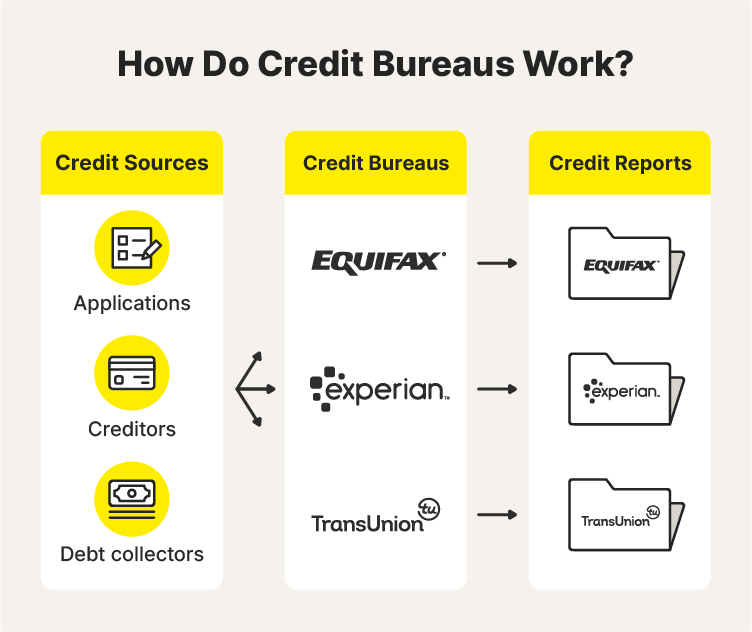Credit Card Refinancing vs. Debt Consolidation: What’s the Difference?
If you have high-interest credit card debt, you may be looking for a way to lower your interest rate and allocate more funds to paying down your principal.
Two popular options are credit card refinancing and debt consolidation. The question is which one, if either, will best help you reduce your debt and improve your personal finances in a reasonable period of time. Here is some information you can use to help you make that decision.
What is credit card refinancing?
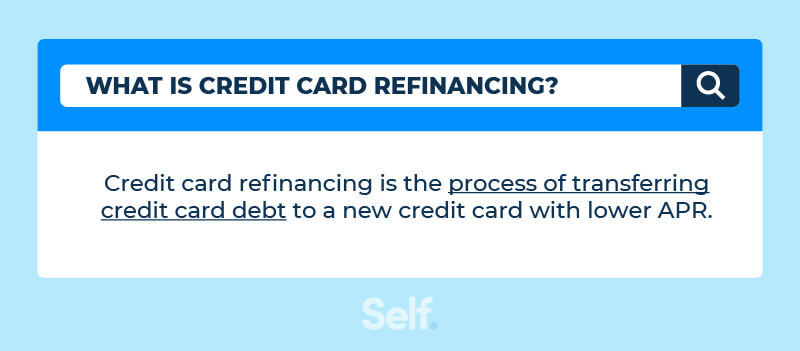
Credit card refinancing is the process of transferring credit card debt to a new credit card with lower APR. [1]
You may want to look for credit cards with introductory 0% APR offers. However, to qualify you’ll need good credit.
Credit card refinancing may help you save money on interest and repay your balances faster, but before deciding if this option is right for you make sure to take into account any fees that may be associated with transferring your debt.
What is debt consolidation?
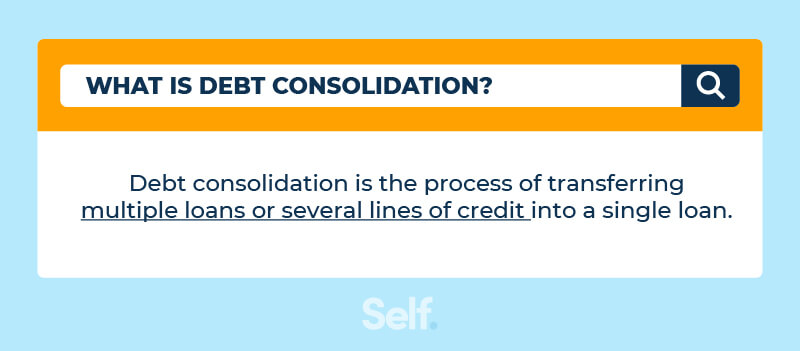
Perhaps you have several different kinds of debt: credit card debt, student loans, medical bills, home equity loans, etc. Debt consolidation is the process of transferring and combining all your debts into a single loan that is paid off by a debt management plan or a debt consolidation loan from a lender. [2]
People use this method if they want to reorganize multiple debt accounts and make loan payments through one single account instead. A consolidation loan comes with fixed loan terms.
Credit card refinancing vs. debt consolidation
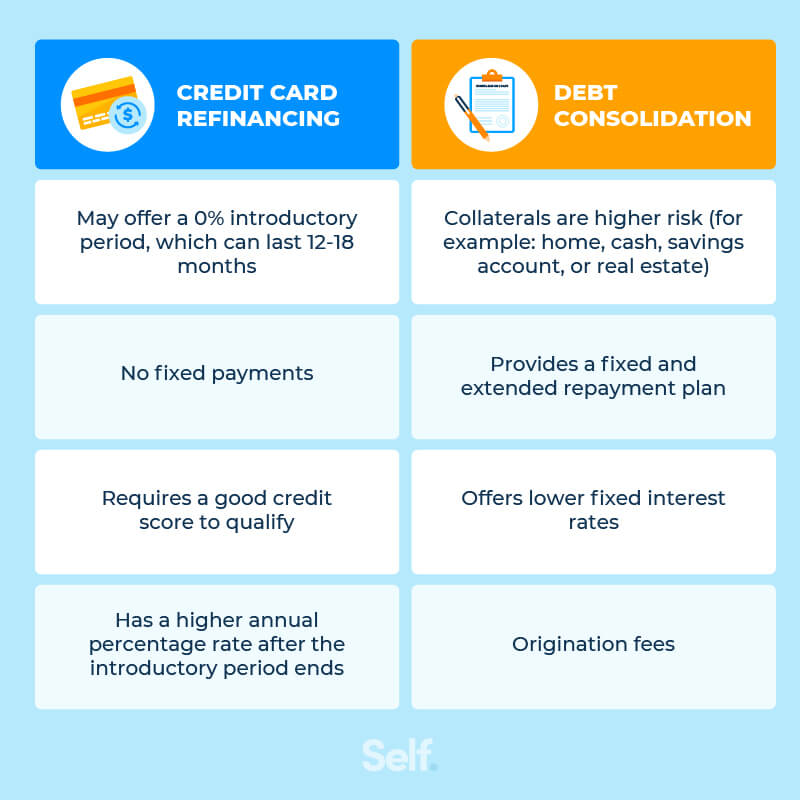
Credit cards and personal loans are both used for refinancing or consolidation. There is some overlap between credit card refinancing and debt consolidation, which can create confusion when making comparisons. Both:
- Offer lower interest rates.
- Are personal loans.
- Require taking out a new loan to pay off debt.
- Lower the cost of paying off your debt by reducing the interest rate.
But key differences between these two options are how your interest rate is lowered, for how long, and the terms of your repayment. The types of loans that can be combined also differ.
Debt consolidation combines multiple loans or several lines of credit into one big single loan. It is essentially a new loan.
- A consolidation loan has a fixed interest rate and payment plan.
Credit card refinancing moves your credit card debt onto a card with lower interest. This often requires using a balance transfer credit card.
- Most balance transfer cards have a 0% introductory APR offer and no fixed payments.
Both these actions will be reflected on your credit report, will impact your credit score, and will hurt your credit history.
The pros and cons of credit card refinancing
If you feel like you have the ability to pay down your debt quickly if you’re given a lower interest rate, credit card refinancing is an option worth exploring.
This option requires discipline, and you should be sure it’s feasible. Why? Because you will have a limited introductory period during which to pay off your balance before the interest rate goes up. Here are some of the pros and cons of credit card refinancing.
Pros
Lower interest rate
Many credit card refinancing offers come with 0% APR, which means you literally pay no interest on your balance for a set period of time, typically between six and 21 months. [3] This means that, during this period, each payment you make goes entirely toward paying down your principal. You can make a lot of progress reducing your debt that way, especially if you make more than the minimum payment.
Reduce monthly payments, interest payments
Paying down your principal during the introductory period has a couple of benefits, even if you don’t pay off your full balance during that period. First, you’ll be reducing the amount of your monthly payment. That’s because it’s typically calculated as a percentage of your balance. Second, because your balance will be lower, you’ll also be paying less interest once it kicks in.
Combine credit cards into one loan
You can transfer balances from multiple accounts onto a single new credit card, which will allow you to put all your debt (or as much as the new card’s credit limit allows) in one place. You’ll want to make sure that the new card is from a different issuer than those you already have. If the new card is backed by the same company as one of the old ones, you won’t be able to transfer the balance from one account to another. [4]
0% percent interest rate
This is the big advantage of this approach. As mentioned, the 0% “introductory” period can vary from as little as six to as long as 21 months. That’s the time during which it’s a good idea to pay down as much debt as possible: the time when you won’t be accruing new interest on the balance you transferred.
Easy application process
Credit card borrowers are often approved within minutes of submitting an application. [5] In fact, many credit card companies send out offers in the mail saying you’ve been prequalified or preapproved for a new card. Some card issuers use these terms interchangeably. However, in general, being prequalified means the lender has done a preliminary review of your creditworthiness. Preapproval more likely means you’re receiving an offer of credit. [6]
Cons
Doesn’t actually get rid of debt
A balance transfer doesn’t reduce your debt. It’s a tool to help you do so. Moving debt from one credit card to another doesn’t actually change how much you owe: If you had $7,500 in debt on three cards, you’ll have $7,500 on your one new card. A balance transfer can give you the opportunity to pay down debt by providing lower interest rates, but it does nothing to address the issues that put you in debt. For that, you can find help in the form of credit counseling.
Higher interest rates if you keep making minimum payments
If you’re just making minimum payments, chances are you won’t be able to pay off your balance by the time the introductory period ends. If that happens, the annual percentage rate can get extremely high, and you may find yourself right back where you started. Then doing another balance transfer may not be easy because your credit may have suffered. Plus, each time you apply for a new credit card, it counts as a “hard inquiry” on your credit report, which can hurt your credit score further.
The introductory rate period ends
Once the introductory period ends, the rate will go up — often significantly. It may be as high as or higher than the rate you were paying on your old cards. In addition, with some cards, the introductory rate only applies to the transfer. It isn’t good on any new purchases you make, which may incur an APR of between 14% and 24%. [3] Of course, if you’re trying to pay down your balance, making new purchases may not help you achieve that goal.
Good credit or excellent credit
Balance transfer cards that offer 0% APR tend to require that you have good or excellent credit. [7] This can be a problem if you’re already struggling to control your debt. For instance, you may be close to maxing out the credit cards you have. If so, you will have a poor credit utilization ratio, which is a key factor in determining your credit score. Even if your application is approved, you may not be able to get a high enough credit limit on a new card to consolidate all your debt.
Should I use a balance transfer credit card?
A balance transfer card is just one type of credit card. Whether it’s the best option for you in reducing your debt depends on a number of factors. If you believe you can pay off all or most of your transferred balance within the introductory period, it can be worth considering, as it can save you hundreds of dollars in interest payments. [8]
You’ll want to consider the impact of balance transfer fees and annual fees, as well as how long the introductory period is. Also, if you have other kinds of debt other than credit card debt, you will likely want to take that into account. For instance, if you have a student loan that carries a 6% interest rate, it can be risky to transfer it to a credit card where the 0% APR introductory rate may jump to 24% after 12 months.
The pros and cons of debt consolidation
Debt consolidation involves taking out a single loan to pay off other debt, and it can cover anything from student loans to medical bills. You’re not limited to credit card transfers. You can use the money to pay off whatever debts you like, whether they’re secured by collateral (such as a car loan) or unsecured.
Pros
Lower interest rates
If you have a number of high-interest loans and you have good credit, you may be able to consolidate them into a single loan with a lower interest rate. [9] This can allow you to pay them off faster. If you can get a debt consolidation loan at 9% and you’re paying 17% and 20% on two credit cards you want to pay off, consolidation will save you money and allow you to pay your debt off faster. But if you’re paying 5% on a car loan, it wouldn’t make sense to include that in your consolidated package.
Fixed repayment plan
The life of the loan is fixed. This means that once you’re done with your payments, you’re done. You can’t accumulate more debt the way you can with a credit card (known as a revolving line of credit). Also, unlike a credit card, the amount you pay doesn’t change from month to month. Under the fixed repayment plan that comes with debt consolidation, you’ll know exactly how much money you need to pay every time.
Easy to manage
Because all your payments are in one place, it’s easier to manage your account. That way, you won’t forget to make a payment, which can harm your credit score if it’s more than 30 days late.
It can improve your credit over time
You can improve your credit score by making consistent on-time payments and lowering your credit utilization rate. Your credit utilization is the amount of debt you have on all your credit cards divided by your total credit limit. So if you remove all your debt from your credit cards and leave them open (but don’t use them), paying down your debt consolidation loan in the meantime can improve your credit utilization ratio.
Cons
Fees
Debt consolidation loans often come with an array of fees, potentially including loan origination fees, balance transfer fees, and annual fees. Origination fees (sometimes called administrative fees) are common for debt consolidation loans. They typically range anywhere from 1% to 6% depending on the lender. [10]
Repayment terms
You may be locked in on the repayment period, and you’ll have to pay a certain amount each month. However, the best debt consolidation loans offer flexible repayment options and don’t charge a prepayment penalty, so you can pay everything off before the discharge date without having to pay a fee. [11]
Creditworthiness
You need to have good or excellent credit to qualify for an unsecured personal loan to consolidate your debt. If you don’t have good credit, you may still get approved, but you will almost certainly wind up paying a higher interest rate, which might even be similar to what you’re already paying. In cases such as these, it’s a good idea to compare your old interest rates with what you’d be paying with a consolidation loan, and add in any fees to estimate your total cost.
Who credit card refinancing may be best for?
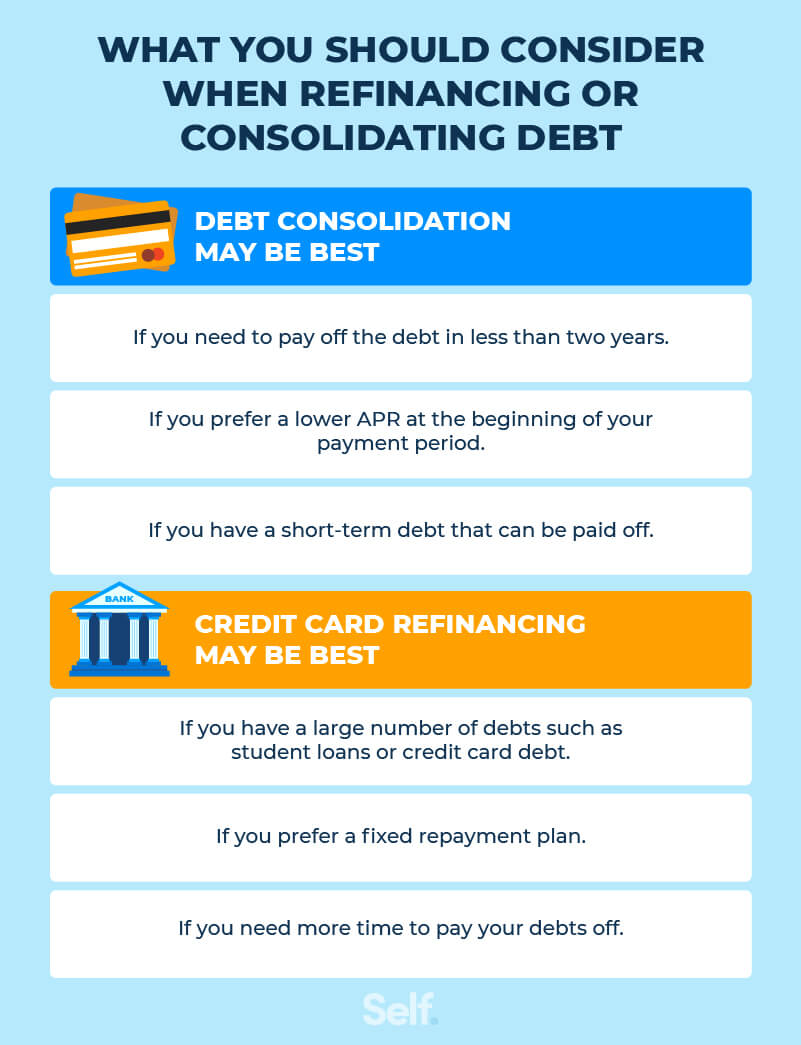
Credit card refinancing may be best for:
- People who can pay off their debt in less than two years, or even better, by the time the introductory low APR expires.
- People who prefer a lower APR at the beginning, and are confident they can get out of debt quickly with a little help from lower interest rates.
- People with smaller debts who can use the lower interest rates to pay them off quickly.
Who debt consolidation may be best for?
Debt consolidation may be best for:
- People who have multiple debts and need more time to pay them off.
- People who prefer fixed payment schedules.
- People with large or several kinds of debt, not just credit cards (medical bills, credit card debt, etc.).
Evaluate your financial situation
Deciding which of these loan options — debt consolidation or credit card refinancing — is right for you depends on your goals and your financial situation. These include:
- The size of your debt and the loan amount you’ll be seeking.
- Your ability to pay, and how quickly.
- Your credit history: what’s the lowest rate you can get?
- Whether you prefer revolving or installment credit.
Once you’ve assessed the pros and cons of debt consolidation and credit card refinancing, you can make an informed decision about whether one or the other (or neither) is right for you.
Sources
- Investopedia. “Refinance,” https://www.investopedia.com/terms/r/refinance.asp. Accessed October 19, 2021.
- Investopedia. “Debt Consolidation,” https://www.investopedia.com/terms/d/debtconsolidation.asp#citation-1. Accessed October 19, 2021.
- CNBC. “How do 0% APR credit cards work? 8 things to know before applying,” https://www.cnbc.com/select/how-do-0-apr-credit-cards-work/. Accessed October 19, 2021.
- CNBC. “Can you transfer more than one balance to a 0% APR card?” https://www.cnbc.com/select/how-many-balances-transfer-0-percent-credit-card/. Accessed October 19, 2021.
- Forbes. “What is Revolving Credit?” https://www.forbes.com/advisor/credit-cards/what-is-revolving-credit/. Accessed October 19, 2021.
- Experian. “Prequalified vs. Preapproved: What’s the Difference?” https://www.experian.com/blogs/ask-experian/pre-approved-vs-pre-qualified-whats-the-difference/. Accessed October 19, 2021.
- CNBC. “How to decide between using a personal loan or a 0% APR card to get out of debt,” https://www.cnbc.com/select/how-to-choose-between-loan-and-zero-percent-apr-card-for-debt/. Accessed October 19, 2021.
- CNBC. “How a balance transfer card can save you hundreds of dollars,” https://www.cnbc.com/select/how-to-complete-a-balance-transfer/. Accessed October 19, 2021.
- Experian. “What Is Debt Consolidation?” https://www.experian.com/blogs/ask-experian/what-is-debt-consolidation/#s1. Accessed October 19, 2021.
- Investopedia. “Best Debt Consolidation Loans,” https://www.investopedia.com/best-personal-loans-for-debt-consolidation-4779764. Accessed October 19, 2021.
- Forbes. “Best Debt Consolidation Loans Of October 2021,” https://www.forbes.com/advisor/personal-loans/best-debt-consolidation-loans/. Accessed October 19, 2021.
About the author
Jeff Smith is the VP of Marketing at Self Financial. See his profile on LinkedIn.
About the reviewer
Ana Gonzalez-Ribeiro, MBA, AFC® is an Accredited Financial Counselor® and a Bilingual Personal Finance Writer and Educator dedicated to helping populations that need financial literacy and counseling. Her informative articles have been published in various news outlets and websites including Huffington Post, Fidelity, Fox Business News, MSN and Yahoo Finance. She also founded the personal financial and motivational site www.AcetheJourney.com and translated into Spanish the book, Financial Advice for Blue Collar America by Kathryn B. Hauer, CFP. Ana teaches Spanish or English personal finance courses on behalf of the W!SE (Working In Support of Education) program has taught workshops for nonprofits in NYC.
Written on February 7, 2022
Self is a venture-backed startup that helps people build credit and savings.
Self does not provide financial advice. The content on this page provides general consumer information and is not intended for legal, financial, or regulatory guidance. The content presented does not reflect the view of Self’s issuing partner banks. Although this information may include references to third-party resources or content, Self does not endorse or guarantee the accuracy of this third-party information. Any Self product links are advertisements for Self products. Please consider the date of publishing for Self’s original content and any affiliated content to best understand their contexts. All trademarks and brand names belong to their respective owners and do not represent endorsements of any kind.
Related articles
- Does Refinancing a Car Hurt Your Credit?
- Does Refinancing Affect Your Credit?
- Refinancing a Car Loan With a 500 Credit Score (Bad Credit)
- Debt Consolidation Loans With a 500 Credit Score
- Does Debt Consolidation Hurt Your Credit?
Credit Card Refinancing: How to Lower Your Interest and Pay Off Debt Faster

If you have several credit cards with different balances and interest rates, keeping track of them and making payments can feel overwhelming. Credit card refinancing—a term that can refer to several credit card debt consolidation methods—is a popular solution for simplifying your finances and potentially saving money.
Below, we’ll explain several ways to refinance credit card debt, including using a personal loan to consolidate it, so you can lower your interest rates and pay off debt faster.
Key Considerations
- There are several ways to refinance credit cards, including personal loans and balance transfer cards.
- Credit card refinancing generally makes sense if it allows you to get a better interest rate or lower monthly payments.
- If you have high-interest, variable-rate balances on multiple credit cards, a personal loan for credit card debt could reduce the amount of interest you pay over time, potentially helping you pay off your debt faster.
What is credit card refinancing?
Credit card refinancing is the process of opening a new credit card with better terms and using it to pay off your existing credit card debt and/or consolidate multiple credit card balances into one.
Those who refinance can potentially get a lower interest rate or a different payment schedule, which can help save on interest and/or pay off debt faster. A common way to refinance credit card debt is by transferring a credit card balance to another card with a 0% promotional annual percentage rate (APR).
However, refinancing debt with a balance transfer comes with some drawbacks, such as transfer fees and temporary promotional periods. To avoid the risk of fees and higher rates following the promotional period, some opt to refinance credit card debt using a personal loan, which comes with fixed interest rates.
How can personal loans help refinance credit card debt?
If you have multiple high-interest cards, a personal loan for credit card debt could help you manage it. A personal loan could also reduce the amount you pay in interest over time.
A personal loan for debt consolidation, sometimes called a debt consolidation loan, is a lump sum of money that you borrow from a lender to pay off some or all your existing debt. Instead of paying several creditors by their due dates, you’ll only pay one creditor each month: the personal loan lender.
You can usually borrow more money with a personal loan to refinance credit card debt than you could using most transfer cards. Plus, these loans come with fixed interest rates that may be lower than your existing variable credit card rates, potentially reducing the total interest paid over the life of the loan.

Advertised rates are subject to change without notice.
Monthly payment is a representative example and for illustrative purposes only.
*Potential savings based off comparing repayment of a $40,000 balance over 7 years on both a credit card with a minimum monthly payment of $992 and APR of 24.20% (average consumer credit card APR per Investopedia as of 3/07/25), with the assumption no additional draws on the line are made during this time; and a BHG Personal Loan with a minimum monthly payment of $716 and minimum available APR for a 7-year term, which is 12.44% as of 06/01/2025 and includes an origination fee.
FYI: BHG Financial’s debt consolidation loans go as high as $250,000 1 and have flexible terms up to 10 years, 1,2 helping you refinance large amounts of credit card debt for a low monthly payment.
What are the benefits of using a personal loan for credit card refinancing?
Choosing a personal loan for credit card debt consolidation can offer several advantages, including:
- Competitive interest rates: If you have good or excellent credit, personal loans can have lower rates than credit card interest rates. This means you’ll pay less interest over time, potentially helping you pay off debt faster.
- Potential to lower credit utilization ratio: Paying off high credit card balances with a personal loan can significantly lower your credit utilization ratio, which is the amount of credit you’re using compared to your total available credit. Your utilization ratio is a key factor for determining your credit score.
- Clear repayment timeline: Personal loans have a set repayment term so you know exactly when your debt will be paid off. Your interest rate is also fixed, meaning you’ll only need to manage one predictable monthly loan payment.
- Larger loan amounts: You can apply for a loan amount that’s enough to cover the balance of the credit cards you want to refinance. For example, BHG Financial offers loan amounts up to $250,000, 1 which is higher than what some other lenders offer.
To truly maximize the benefits of a personal loan, it’s essential to partner with a trusted lender like BHG. With tailored consolidation loan options, competitive rates, and exceptional service, BHG makes it easy to manage your debt and stay in control of your financial goals.
What are the alternatives to personal loans for refinancing credit card debt?
While personal loans are a popular credit card refinancing option, there are alternatives to consider:
1. Balance transfer credit cards
You can combine existing credit card balances into one with a 0% or low introductory APR using a balance transfer card (just make sure you stay within the card’s transfer limit). Here, you’ll save money on interest while you work to pay off the balance in full. However, some credit card issuers charge a balance transfer fee ranging from 3% to 5%. And introductory periods have expiration dates—if you do not pay off the balance before the end of that period, you will be subject to the card’s standard variable interest rate.
2. Debt management plans
Non-profit credit counseling services can negotiate a debt management plan with your creditors that may include lower interest rates and reduced fees. However, some credit card companies may not agree to the plan. These agencies also charge a fee for their services, and the plans usually require a three- to five-year commitment.
3. Credit repayment strategies
The debt snowball and avalanche methods are two popular ways to attack credit card debt at a reasonable pace without exhausting your finances. Using the debt snowball method, you pay off your smallest debt first, regardless of the interest rate, before tackling larger balances. This strategy helps you build momentum with quick wins.
Paying off debt with the avalanche method involves prioritizing the debts with the highest interest rate, a strategy that helps you minimize the amount of interest paid over time, thus reducing the total cost of your debt.
Of course, any time you can pay more than the minimum card payment, you should. This allows you to allocate more funds to the principal balance, which helps you pay it down faster while also saving on interest. Review your monthly budget and identify areas where you can cut back spending, so you can use that money to make more progress toward becoming debt-free.
Credit card refinancing FAQ
Can refinancing credit card debt with a personal loan improve my credit score?
Yes, it can. When you use a personal loan for credit card debt consolidation, it can improve your credit utilization ratio. The amount of credit you use goes down as you pay off revolving debt like high card balances, which can lead to a better credit score. Also, maintaining a history of on-time payments on your loan can positively impact your score over time.
What is the difference between credit card refinancing and debt consolidation?
While the terms are often used interchangeably, credit card refinancing specifically refers to replacing your existing credit card debt with a new form of credit. Debt consolidation is a broader term that encompasses combining multiple debts into a single loan, which can include credit cards, personal loans, or other types of debt. Using a personal loan for credit card debt is one way to refinance debt using the debt consolidation method.
Are there risks associated with using personal loans for credit card refinancing?
While personal loans offer many benefits, it’s important to consider the potential drawbacks that could impact your overall cost. Interest rates are primarily determined by credit score, and even a small change in the rate you’re approved for could significantly increase or decrease the cost of the loan. Some lenders may also charge a one-time origination fee to take out a personal loan. If you decide to refinance your debt with a personal loan, stick to a budget so you don’t overspend and fall back into the same debt cycle.
How do I qualify for a personal loan to refinance my credit card debt?
To qualify for a personal loan, lenders will look for strong financial indicators, such as a good credit score and verifiable income and employment history. Consideration is also given to your debt-to-income ratio (DTI). These eligibility factors indicate that you have a history of responsible money management, which gives lenders confidence that you can afford to take on an additional loan.
How BHG can help you refinance credit cards
At BHG Financial, we believe financing should fit seamlessly into your life and goals. That’s why we offer personal loans tailored to your needs, with amounts up to $250,000 1 and flexible terms of up to 10 years. 1,2 Consolidate your high-interest credit card debt with a BHG loan designed to help you move forward confidently.
Plus, you’ll enjoy dedicated, U.S.-based concierge service that works around your schedule—because your time is valuable. Ready to see what’s possible? Use our quick and easy payment estimator to get your personalized loan estimate in just seconds.
Not all solutions, loan amounts, rates or terms are available in all states.
1 Terms subject to credit approval upon completion of an application. Loan sizes, interest rates, and loan terms vary based on the applicant’s credit profile.
2 Personal Loan Repayment Example: A $59,755 personal loan with a 7-year term and an APR of 17.2% would require 84 monthly payments of $1,228.
Annual percentage rates (APRs) for BHG Financial personal loans range from 11.96% to 27.87%, with terms from 3 to 10 years.
Consumer loans funded by Pinnacle Bank, a Tennessee bank or County Bank. Equal Housing Lenders.
No application fees, commitment, or impact on personal credit to estimate your payment.
For California Residents: BHG Financial loans made or arranged pursuant to California Financing Law license – Number 603G493.
* BHG monthly payment based on BHG’s minimum available APR for a 7-year term, which is 12.44% as of 4/1/2025 and includes an origination fee. Your actual loan size, loan term, and monthly payment amount may vary based on your individual credit profile and other information provided in your loan application. Terms subject to credit approval.
** The savings estimate assumes a fixed-monthly payment is made on the variable APR credit card and no additional draws on the line are made for the 7-year period.
https://www.self.inc/blog/credit-card-refinancing-vs-debt-consolidationhttps://bhgfinancial.com/personal-loans/debt-consolidation/credit-card-refinancing

